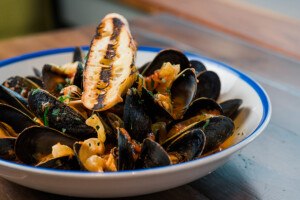What You Missed at José Andrés' Harvard Lecture Last Night
Last night, crowds lined up around the Harvard Science Center again to get schooled in food and science. While last week marked the return of Chicago-based chef Grant Achatz, this week’s lecture was from D.C.-based superchef José Andrés, whose ThinkFoodGroup is a sponsor of the university’s Science + Cooking course. Andrés took the mic to lecture on gelatin, and managed to demonstrate about a dozen different gelatin techniques using only water. “I think it’s a very clean way to explain gelatin,” he explained to us before the talk. “Using a white canvas like water, we can focus on the true message.”
As the chef had a couple of days to kick around town, he told us that he hit up a couple of local restaurants, including Salts in Cambridge—where his young daughters impressively downed a full tasting menu—and Island Creek Oyster Bar.
In the slide show above, get a peek at the charismatic chef’s demos in action and some of the best one-liners of the night. Below, Andrés’ lecture in a nutshell:
We often think of gels as an out-there component in modern cuisine, but they’re hardly new.
“People of Cambridge, they have been with us for centuries,” Andrés said, claiming that the use of gelatins has roots in everywhere from Asia to Ireland. “The great-great-grandfather of my mother was probably using gelatins,” he said. Another misconception is that they are synthetic products that our bodies shouldn’t process. In fact, most gelatins are naturally derived from seaweed, animal proteins, fruit pectins or vegetables.
We can lower the fat content of our food by using gelatin.
Gelatins can thicken sauces and be whipped into thick whipped cream-like substances, which can eliminate the need for butter or heavy cream in certain dishes while intensifying flavor. As an example, Andrés said that a mixture of strawberry puree and gelatin when pushed through a whipped cream canister will generate enough air bubbles for a mousse, and keep the strawberry flavor 100% pure rather than adulterating it with cream.
Gelatins can also help make our food more sustainable.
Shark fin soup is considered a traditional longtime Chinese delicacy, but it’s incredibly controversial since the star ingredient is obtained often by killing sharks just for the fin. In fact, California recently banned the dish from being served. Andrés said the texture of shark fin soup is “amazing,” and that “the chef in me would tell me that I want to keep eating this shark fin—it is tradition.” However, he has discovered that by grating a new type of bacterial fermented gelatin with a microplane, he can mimic the texture of shark fin cartilage. “This is a way that through chefs cooking and you eating, we can make a better world for tomorrow,” he said.
By re-imagining common foods with gelatins, we can make them better.
One of Andrés’ signature dishes is a re-worked baby corn cob, made from shaving off the corn kernels, mixing them with methyl-cellulose gelatin (a plant derivative that firms up when heated), wrapping the mixture around a a tube of agar-agar gelatin (a seaweed derivative that softens when heated over 80 degrees Celcius) that’s made with corn water, and heating it up. “Why do we do this? Because we believe that we make a better corn,” Andrés said. “When you put this corn in your mouth, the texture is astonishing.” Andrés also demonstrated a cheese-filled ravioli surrounded by “pasta” made from agar-agar, stating that this also makes the dish friendly for those on gluten-free diets.
When it comes to traditional vs. modern cuisine, it’s not one or the other.
During the Q&A period, Andrés shared his frustration with food writers and critics who pit traditional cooking against molecular gastronomy. “The traditions of today were modernity 200 years ago,” he said. He certainly straddles both sides of the line, serving his take on historical American cuisine at his D.C. pop-up America Eats Tavern, as well as progressive, molecular fare at minibar in D.C. and The Bazaar in Los Angeles. “We should all be involved in the avant-garde as long as we look toward the past,” he explained.


